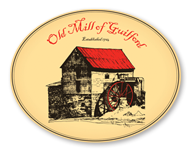History
OUR HISTORY
In 1767, before the colonists decided to seek independence from England, Daniel Dillon built a small tub mill in North Carolina on Beaver Creek, and went into business grinding grain for the early settlers. The Earl of Granville had granted Dillon the tract of 552 acres on Reedy Fork and Beaver Creeks in 1755. Rowan County later granted him a license to build the mill in 1764. Rowan County court minutes from January 10, 1764 read: “Ordered that Daniel Dillon have License to Build a Publick Grist Mill on the Reedy Fork of Haw River at the mouth of Beaver Creek.” The mill was located in what is now Guilford County, which was created out of Rowan County in 1771.
On February 10, 1781, during the Revolutionary War, British troops under General Cornwallis marched past the mill in pursuit of General Greene who was encamped at Guilford Courthouse. Legend has it that British troops seized the mill to grind grain for the soldiers prior to the Battle of Guilford Courthouse on March 15, 1781.
The original tub mill and dwelling on 175 acres was sold to Joel Sanders for $900 in 1808. In 1819, Sanders moved the mill 500 feet down stream and built a new dam across the creek, which increased the millpond to 10 acres. The new mill was designed as a merchant corn and wheat mill with an overshot wheel to replace the small tub mill.
In 1913, the mill was purchased by K. L. Hendrix who later converted the mill to a roller mill and replaced the water wheel with a turbine. In 1932, state highway 68 was built between the dam and the mill. To keep the mill in operation, the long overhead wooden flume, which carried water from the dam to the mill, was replaced by a 26″ diameter steel pipe which ran under the new road. Clarence E. Bailes purchased the mill in 1954. Bailes removed the roller mill machinery and replaced the turbine with a 24’ x 4’ Fitz overshot water wheel which still operates today.
Timbers were shored up and a few replaced. A new metal roof was installed and shingles were put on the outside walls over the existing siding.
A small addition was added to the side of the mill to serve as a sales office. Corn cleaners, bolters, and dust agriculture regulations were installed so that the mill could operate on a commercial basis. Mr. Bailes also replaced the metal pipe carrying water from the pond to the wheel and built a separate feed mill next to the existing mill. Lloyd Lucas became miller and operated the mill until his death in 1975 at which time the mill was closed.
In 1976, C.E. Bailes sold the mill to James Flynt of Old Mill, Inc.
Old Mill Inc. was sold to Charles Parnell of Bailes Old Mill, LTD., in 1977. Mr Parnell renovated the mill which had suffered from its two years of disuse and resumed its operation as a water-powered grist mill in keeping with its over 200 year tradition. Mr Parnell married Heidi Brandt and together they ran the mill. With the help of volunteers they developed a variety of new mixes and established a national reputation for quality products.
The water wheel was repaired in 2007. The Parnells both died that year. Annie Laura Perdue became miller after many years of training under Charles Parnell.
CURRENTLY
In 2008, Alice and Darrell Klug purchased the Old Mill of Guilford from Mrs. Parnell’s brothers, Hans and Alfred Brandt. Annie Laura Perdue remained the miller. Volunteers from the community assist in running the mill. The Klugs continue to introduce new products, maintain the historical integrity of the mill and enhance the mill’s reputation for high-quality, natural stone-ground products.


